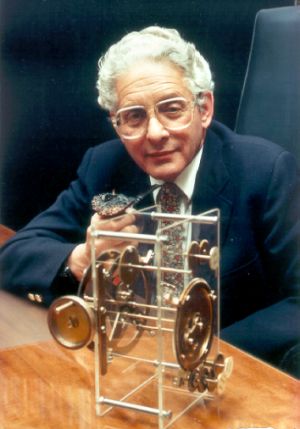Science Since Babylon: Difference between revisions
m (→References) |
|||
| Line 68: | Line 68: | ||
===Summary=== | ===Summary=== | ||
===References=== | ===References=== | ||
*[https://en.wikipedia.org/wiki/Abraham_Flexner Abraham Flexner] | |||
== 7. Mutations of Science == | == 7. Mutations of Science == | ||
Revision as of 20:38, 27 May 2020
Science Since Babylon was written by Derek J. de Solla Price based on a series of five lectures he delivered at Yale University's Sterling Memorial Library in October and November 1959 on the history of science. In 1961 it was published in London and New Haven by Yale University Press, and sold as a Yale Paperbound (paperback) in 1962. It is notable due to Price's observation of the exponential trajectory of scientific growth, and his subsequent prediction of that growth leveling off due to saturation. The book is often cited by Eric Weinstein for its observations about growth. Weinstein also notes that it is odd how few people know about this book.
An Open Access PDF of the book is available here.
Preface to Enlarged Edition
Preface to Original Edition
1. The Peculiarity of a Scientific Civilization
Summary
References
- Srinivasa Ramanujan
- Professor G. H. Hardy of Cambridge
- 1729
- Herbert Butterfield and The Origins of Modern Science
- Almagest by Ptolemy
- Niels Bohr's Principle of Complementarity
- Babylonian mathematics
- Greek mathematics
2. Celestial Clockwork in Greece and China
Summary
References
- Whipple Museum of the History of Science
- Astrolabe
- A Treatise on the Astrolabe by Chaucer
- Escapement
- Astrarium, a clock built by Giovanni de' Dondi in 1364
- Science and Civilisation in China, initiated and edited by Joseph Needham
- Song dynasty
- Antikythera mechanism, short documentary
3. Automata and the Origins of Mechanism and Mechanistic Philosophy
Summary
References
- Jean Froissart's L'Horloge Amouresuse and L'Horloge de Sapience
- Albertus Magnus
- St Thomas Aquinas' Summa Theological
- "beast-machine"
- Jonathan Swift's Yahoos
- Pascal's Pascaline of 1645: how it works
- musical automata of Achilles Lagenbucher of Augsburg
- waterworks of Canterbury Cathedral
- Duc Philippe, Count of Artois, castle of Hesdin, and the Garden of Earthly Delights, described in Magic and Mechanics in Medieval Fiction by Merriam Sherwood
- Polish scholar Witello
- Tower of the Winds, The Roman Agora in Athens: drone tour
- Strassbourg astronomical clock, made by Isaac and Josias Habrecht— watch it in action
- Cornelis Drebbel and his magical oven
- Cave of Lascaux: virtual tour, wiki article
4. The __, __, and __, and Other Geometrical and Scientific Talismans and Symbolisms
Summary
References
- The Curious History of the Six Pointed Star by Gershom Scholem
- On the Sphere and Cylinder by Archimedes
- Chen-ning Yang
- Square root of 2 Proofs of irrationality

